This article was published in Scientific American’s former blog network and reflects the views of the author, not necessarily those of Scientific American
Our new book, Champions of Illusion: The Science Behind Mind-Boggling Images and Mystifying Brain Puzzles, is now out!
Our publisher, the joint imprint of Scientific American and Farrar, Straus and Giroux, did a beautiful job printing all the gorgeous illusions in full color and making them pop. And there is a lot more than meets the eye! In addition to illusions that can be printed on a page, there are many stunning visual effects that are best enjoyed on a computer screen. Over the next several weeks, we will use this space to share illusions from the Best illusion of the Year Contest that, due to their dynamic nature, are not featured in depth in Champions of Illusion.

Credit: Champions of Illusion Book
On supporting science journalism
If you're enjoying this article, consider supporting our award-winning journalism by subscribing. By purchasing a subscription you are helping to ensure the future of impactful stories about the discoveries and ideas shaping our world today.
Rolling Eyes on a Hollow Mask and the Exorcist Illusion
Vision researcher Thomas Papathomas and his colleagues (technician Tom Grace, Sr., artist Robert Bunkin, and computer graphics expert Marcel de Heer) at Rutgers University have created some unusual versions of the Hollow Mask illusion. In the classic hollow mask illusion (which you can see in Disneyland’s Haunted Mansion, or in Gaudi’s Sagrada Familia church in Barcelona, among other places), a mask is placed in front of a light source, with its open back facing the viewer. Although the mask is concave, our brains assume that all faces are convex. While a convex face would look in only one direction, a hollow face appears to look forward when the viewer is directly ahead, but at an angle when the viewer moves sideways. In another well-known demonstration, when a hollow mask rotates on a turntable, it appears to turn opposite to the turntable’s actual direction.
Papathomas attached three-dimensional eyeballs and a nose ring to a hollow mask. When the mask rotates, the eyeballs and nose ring appear to turn in the opposite direction to that of the face.
Next, the team drew inspiration from the classic horror flick The Exorcist (and Linda Blair’s impressive head-spinning as a demon-possessed girl) to produce a “hollow body” illusion. Papathomas and his colleagues had previously painted the inside of a hollow mask to make it appear to protrude. Now they paired a hollow mask with a nonhollow torso, and vice versa. The sculptures have no moving parts, but when the head-torso composites are rotated, “the effect is a flexible, twisting neck out of a 3-D rigid [body], like in The Exorcist,” Papathomas says. This illusion reveals some of the biases the brain uses to interpret the orientation of faces and bodies. For example, your brain assumes that people’s faces and bodies are lit from above, by the sun. So when you view a hollow mask or body and the lighting orientation appears reversed, so does the rotational direction. Watch the video below to watch the head of the devil’s spawn do an illusory 360 around its torso.
Thomas Papathomas answered a few questions about his illusion creations (edited for clarity):
Illusion Chasers: How do your illusions work, and what do they tell us about our mind and brain?
Papathomas: The hollow mask is an example of a class of illusions that are known as “depth-inversion illusions (DII)”. We perceive the hollow mask as a regular convex face (DII) because of prior stored knowledge that faces are convex. A result of the depth inversion is that we perceive a rotating hollow mask as a convex face that rotates in the opposite direction to that of the physical direction of rotation. However, if we add an external 3-D object (such as a nose ring), this object is not perceived as depth-inverted, hence it will be perceived to rotate in the physical direction of rotation. This creates the shearing motion illusion, in which the face and the nose ring appears to rotate in opposite directions.
Both the Rolling Eyes on a Hollow Mask and the Exorcist Illusions are based on the following two observations for 3D objects that rotate around an axis: (1) If the 3D object’s depth is perceived as it physically exists, then it will appear to rotate in the true, physical direction of rotation. (2) On the other hand, If the 3D object’s depth is inverted (concavity perceived as convexity and vice versa), then it will appear to rotate in the opposite direction to the physical direction. The 3D “Exorcist illusion” is constructed as a “sculpture” with two components that are both realistically painted: a torso and a face. The torso is concave and the head is convex, or vice versa. Because of our stored knowledge that torsos and faces are convex, only the concave component is depth-inverted and rotates in the opposite direction. As a result, the neck appears to twist.
As in the Rolling Eyes on a Hollow Mask, the Exorcist Illusion shows us that what we ultimately perceive does not depend only on the data-driven sensory signals that arrive to the eyes but also on prior knowledge that influences how we interpret these sensory signals.
Illusion Chasers: Do your illusions relate to any experiences we might have in our daily lives?
Papathomas: Depth inversion illusions happen rarely in daily life; they are almost exclusively generated by stimuli that are contrived by illusionists who take advantage of how stored knowledge influences the perception of 3D objects.
Interestingly, depth-inversion illusions could be used as a diagnostic tool for schizophrenia, because it turns out that patients tend to perceive such illusions less than controls. We are working with Dr. Steven Silverstein, an expert in schizophrenia, to develop diagnostic tools based on this type of illusions.
Illusion Chasers: How did you discover your illusions?
Papathomas: I knew that the opposite-rotation-direction effect for a hollow mask is due to depth inversion. Then I started thinking of 3D objects that, if added to the hollow mask, would not get depth-inverted, and thus move in the physical motion direction. I added spherical eyeballs and a nose ring, and sure enough, they did the trick of rotating in the physical direction, opposite to the direction of the mask.
To create the Exorcist Illusion, I reasoned that there is nothing unique about our stored knowledge that faces are convex. Thus, our visual system must also have stored knowledge that bodies are convex. I experimented with concave torsos and I confirmed my prediction that, under certain general conditions, torsos are depth-inverted, and people perceive them as convex. Then, we set out to merge a concave torso and a convex head. This was a straightforward step, albeit mechanically challenging.
